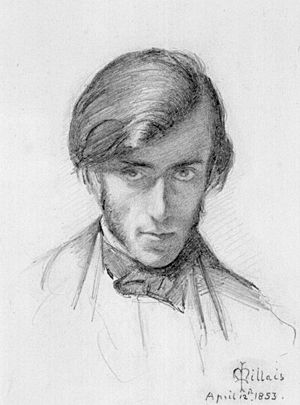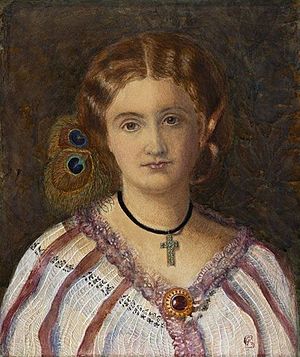Frederic George Stephens facts for kids

Frederic George Stephens (born October 10, 1827 – died March 9, 1907) was a British art critic. He was also a special member of the famous Pre-Raphaelite Brotherhood. This group of artists wanted to change art in England. Stephens was one of only two members who were not artists themselves.
Contents
Early Life and Art Training
Frederic George Stephens was born in Walworth, London on October 10, 1827. He grew up nearby in Lambeth. When he was ten years old, an accident left him with a physical disability. Because of this, he was taught at home for some time. Later, he went to University College School in London.
In 1844, Stephens joined the Royal Academy Schools. This is where he met two important artists: John Everett Millais and William Holman Hunt. In 1848, he became part of their new group, the Pre-Raphaelite Brotherhood.
Stephens often posed for his artist friends. You can see him in famous paintings like Millais's Ferdinand Lured by Ariel (1849). He also appears in Ford Madox Brown's Jesus Washing Peter's Feet (1852–56). A drawing of Stephens by Millais from 1853 is kept at the National Portrait Gallery, London.
From Painter to Critic
Stephens tried to be a painter himself. However, he felt he wasn't very good at it. Because of this, he decided to stop painting and become an art critic instead. He later said he destroyed all his paintings. But some of his works are still around today.
Three of his paintings are at the Tate Gallery in London. These include The Proposal (The Marquis and Griselda) (1850–1) and Morte d'Arthur (1849). Another painting is Mother and Child (around 1854–6). A pencil drawing of his stepmother, Dorothy, is also at the Tate. He even showed a portrait of his father at the Royal Academy in 1854.
A large drawing called Dethe and the Riotours (1848–54) is at the Ashmolean Museum in Oxford. This drawing shows a scene from Geoffrey Chaucer's The Pardoner's Tale.
Becoming an Art Critic and Historian
Frederic Stephens played a key role in telling the public about the Pre-Raphaelite Brotherhood's goals. He became the art critic for a well-known magazine called the Athenaeum in 1860. He later became its art editor and worked there until 1901.
He also wrote for other art magazines. These included The Art Journal and The Portfolio. Stephens even wrote for journals in other countries, like The Crayon in the United States. This magazine supported the Pre-Raphaelites. He used different pen names, like Laura Savage, when writing for the Brotherhood's own magazine, The Germ.
Writing About Art History
Stephens started writing books about art history. His first book, Normandy: its Gothic Architecture and History, came out in 1865. The next year, he published Flemish Relics, which was about art from the Netherlands. He also wrote books about specific artists like William Mulready (1867) and Edwin Landseer (1869).
From 1873, he wrote nearly 100 articles for the Athenaeum about art collections in Britain. These articles talked about both large and small collections. This helped more middle-class people become interested in buying art.
In 1875, Stephens began to see himself more as an art historian than just a critic. He started writing for the Grosvenor Gallery art show catalogues in 1877. He continued this work until 1890. He also worked at the British Museum. There, he helped write the first parts of the Catalogue of Prints and Drawings in the British Museum.
Friendships and Disagreements
Stephens was a loyal friend to William Holman Hunt for many years. However, their friendship ended over Hunt's painting The Triumph of the Innocents (1885). Hunt had asked Stephens to help transport the painting, but it got lost and damaged.
Later, Stephens wrote a review of the painting. He criticized it for mixing very realistic details with fantasy. Hunt was upset by this. Years later, Hunt wrote negatively about Stephens in his own book, Pre-Raphaelitism and the Pre-Raphaelite Brotherhood.
Despite this, Stephens continued to write about art. In 1894, he published a book about Dante Gabriel Rossetti. He also wrote essays for a large history book called Social England. In these essays, he suggested that Pre-Raphaelite art was part of a long tradition in British art. This was different from what the Brotherhood believed. He also wrote a book about Lawrence Alma-Tadema in 1895.
Stephens wrote about many other artists too. These included Thomas Bewick, Edward Burne-Jones, George Cruikshank, Thomas Gainsborough, William Hogarth, Samuel Palmer, Joshua Reynolds, and Anthony van Dyck.
Stephens had very traditional views on modern art. He strongly disliked Impressionism, a new style of painting. This disagreement eventually led to him leaving the Athenaeum after forty years.
Later Life and Family
In 1866, Frederic Stephens married an artist named Rebecca Clara Dalton. They lived in Hammersmith, west London, from 1866 to 1905. Their son, Holman Fred Stephens (1868–1931), became a railway engineer.
Frederic George Stephens passed away at his home on March 9, 1907. He is buried in Brompton Cemetery. After his wife died, many of his art pieces and books were sold. However, his son later gave several works of art to the Tate Gallery.
A Famous Unfinished Poem
Stephens is sometimes remembered for a poem he never finished. He started writing a political sonnet for the first issue of The Germ magazine. By October 1849, he had written 11 and a half lines. His friend James Collinson thought they were "the best of all." A month later, it had reached 12 lines, with a "tremendous idea" planned for the last two. The magazine came out in January 1850, but the poem was never published.


